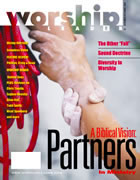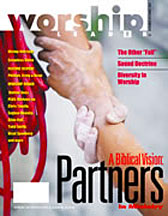A Resource by Mark D. Roberts |
|
To jump to comments, click here.
Back and Forth: An Interactive Web-Based Conversation |
|
|
|
|
Topic:
A Biblical Vision -
Partners in Ministry
|
Welcome to my first “Back and Forth: An Interactive Web-Based Conversation.” The focus of this dialogue will be my current article in Worship Leader magazine, “A Biblical Vision: Partners in Ministry.”
Here’s how you can participate:
1. If you wish, you can simply read the article, clicking on any highlighted blue links if you want more information.
2. If you have any questions or comments about my article, or if you’d like clarification or want to raise an objection, simply send me an e-mail. In this e-mail please include:
• The sentence or section that has sparked your interest, so I can locate my response in the right place.
• Then ask your question or offer your criticism or whatever.
• If you wish, you can respond to several sentences or sections in one e-mail. When you’re done writing, just send the message to me.
3. When I receive your e-mail, I’ll do the following as quickly as I am able: a) Write a response. b) Put my response up on my website, linking it to the appropriate sentence or section of the article. c) Send you an e-mail telling you that I’ve responded.
4. If you’d like to respond to my response, go right ahead. We can keep the conversation going, with results posted for others to see.
(Note: I had thought that I’d simply put up an annotated version of my article. But I think the “Back and Forth” modality has greater possibilities. It means I can really respond to what’s on the minds of my readers, including you. And it keeps me from putting up all sorts of stuff that really isn’t relevant.)
Thanks for joining this “Back and Forth” conversation!
As of 11/9/04, I have put up 4 comments.
To jump to comments, click here.
And now for the article . . . .
A Biblical Vision: Partners in Ministry
© Copyright Worship Leader 2004. All rights reserved. Please do not retrieve or reprint this article without the expressed permission of Worship Leader magazine. They are actually quite generous with giving permissions, by the way. For permission, contact the editor.
from Worship Leader, Nov/Dec 2004, pp. 15-17
| By the way, if you like this article, there are lots more like this in Worship Leader magazine. Regular columnists include such leading thinkers as Sally Morgenthaler and Robert Webber. Lots of album reviews, tech info, and personal stories as well. If you're not already a Worship Leader subscriber, I highly recommend it! -- Mark |
 |
| Click for subscription info |
by Mark D. Roberts
Contemporary arguments for or against the inclusion of women in church leadership follow diverse paths. Some arguments focus on the interpretation of a few controversial biblical texts, while others stress the experiences of godly women. Some point to spiritual gifts, while others emphasize missional necessity. But, in my experience as a pastor and seminary professor, most Christians who wander into the thick forest of this conversation lack a broad biblical vision, a roadmap that can help them along the path to biblical obedience and divine blessing.
In this article I want to offer a glimpse of this panoramic vision. Though I can’t begin to address the myriad of scriptural details subsumed by this vision, I hope nevertheless to paint with a broad brush God’s intentions for humanity. This expansive picture will help us see and evaluate the biblical details from a fresh, truthful perspective. It will challenge both our scriptural interpretations and our practical applications.
Here is the biblical vision in a nutshell: God intends for men and women to be full partners in his work in the world. This work surely includes worship leadership, where the biblical case for partnership is especially clear, as we’ll soon see.
Partnership in Creation
Male-female partnership is featured in the opening chapters of the Bible. There God creates humanity in his own image, an image of male and female (Genesis 1:27). God assigns equally to both man and woman the responsibility of filling the earth and ruling over its creatures (verse 28). Leadership is to be exercised by man and woman working together.
Genesis 2 provides a different perspective on creation. In this chapter God first creates the man and then adds “a helper suitable for him” (Genesis 2:18, NIV). The word “helper” in Hebrew carries no sense of subordination. In fact it usually speaks of the superior help God supplies (see Psalm 121:1-2). Yet the point of Genesis 2 is not the woman’s superiority, but rather the deep partnership between her and the man.
Partnership Distorted by Sin
This sweet beginning quickly turns sour, however, as sin distorts God’s intentions for man and woman. The first stated result of sin is brokenness in the relationship between the sexes (Genesis 3:7). This is reiterated when God says that, now, the man “will rule over” his wife (verse 16, NIV). The intimate, mutual, thoroughgoing partnership intended by God has been corrupted by sin.
The Old Testament supplies ample evidence of this corruption. Men generally rule without having women as their partners, often victimizing women in the process (for example, Genesis 12:10-20; Judges 19).
Old Testament Exceptions
Yet the Old Testament includes occasional exceptions to the rule of male dominance. Miriam, the sister of Moses and Aaron, is a prophet who, along with her brothers, leads Israel out of bondage and Israel’s women in worship (Exodus 15:21-21, Micah 6:4). The most striking Old Testament example of female leadership is the case of Deborah who, as a prophetess and a judge, leads the entire nation of Israel (Jud 4-5). Though teamed up with the man Barak, she is the primary leader of God’s people, whom he blesses under her strong, maternal hand.
Partnership in the Ministry of Jesus
Although Jesus’s inner circle comprises twelve men, he is consistently inclusive of women, thus foreshadowing the partnership yet to come. Not only did Jesus always treat women with the respect, he included them among his students (Luke 10:38-42) and his traveling companions (Luke 8:1-3). Women bear witness to Jesus during his earthly life (John 4:28-30). Even more strikingly they are the first ones to announce the good news of the resurrection (Luke 24:1-12).
Yet, far more than his example, it is the death and resurrection of Jesus that enables the full restoration of the partnership between man and woman. The cross defeats sin and its power, thus leading to reconciliation, not only between humanity and God, but also between a divided humanity (see Ephesians 2:11-21, Galatians 3:23-29).
Pentecost, Partnership, and the Holy Spirit
At Pentecost Jesus sends the Holy Spirit to empower his disciples for ministry. In fulfillment of Joel’s prophecy, the Spirit is poured out specifically upon both sexes: “[Y]our sons and daughters will prophesy . . . . Even on my servants, both men and women, I will pour out my Spirit” (Acts 2:16-18, NIV). This means that women, along with men, will be empowered for ministry in the church, even the all-important ministry of prophesying (delivering God’s word with divine authority). God’s created intention of partnership between the sexes will, by his indwelling power, begin to thrive. Woman and men participate in God’s work, not because they have the right to do so, but because the Spirit equally endorses and empowers them.
In 1 Corinthians 12-14 the Apostle Paul spells out in detail the theological implications of the outpouring of the Spirit. The Holy Spirit gives various gifts to all believers so that they might build up the church. Paul neither states nor implies that certain gifts are given only to men or only to women. Rather, all gifts may be given to all people according to the Spirit’s own choice. When the community gathers, each person is expected to contribute to the assembly by teaching, or singing, or prophesying (14:26). In 14:34-35 Paul tells women who were interrupting the meetings with their inappropriate questions to keep quiet, but otherwise all people, both men and women, are encouraged to minister in all spiritual gifts.
Partnership in the Ministry of Paul
It should come as no surprise, therefore, that the Pauline letters contain numerous cases of male-female partnership. Yet, because we often associate Paul with a few passages that seem to limit the ministry of women, we might be surprised by what he actually says about women in his own ministry.
Consider Romans 16; Paul begins this chapter by commending a Christian woman named Phoebe, who has been active in Paul’s ministry and who is identified as a “deacon” (verse 1, NLT; from the Greek word, diakonos, sometimes translated as “minister” or “servant”). Next Paul greets Priscilla and Aquila, whom he calls his “fellow workers in Christ Jesus” (v. 3, NIV). This Christian couple leads a church that meets in their home (vv. 4-5). Later Paul mentions “Andronicus and Junia” who “are respected among the apostles” (v. 7, NLT). This verse has been controversial among interpreters because, when read literally, it identifies Andronicus (a man) and Junia (a woman) not only as “apostles,” but even as highly regarded apostles. It’s likely that Andronicus and Junia were a married couple, both of whom were active as church planters.
To cite one further example, in Philippians 4 Paul mentions that two women, Euodia and Syntyche, “have contended at my side in the cause of the gospel, along with Clement and the rest of my fellow workers” (v. 3). Thus the Apostle Paul regularly included women in his apostolic ministry, utilizing their gifts as his full partners.
Problems in Corinth and Male-Female Partnership in Christ
Yet the partnership between the sexes didn’t get off to a smooth start in the first century. Given the fact that this sort of collegiality was socially suspect, and that men and women were not accustomed to participating together in corporate gatherings, and that most women were uneducated, and that women tended to be held in low esteem in first-century culture, and that women often associated religion with ecstatic and orgiastic behavior, the obstacles to male-female partnership were legion. Not only were some men disinclined to include women in ministry, but also some women interpreted their freedom in Christ as a license to minister independently of men and their concerns.
This happened in Corinth when women removed their head-coverings in the Christian gatherings even though this was culturally inappropriate, immodest, and troubling to the men of the congregation (1 Corinthians 11:2-16). In response to this behavior Paul clearly affirms the right of women to pray and prophesy in the assembly (verse 5). After all, they are gifted by the Spirit for such ministry, a ministry we would call worship leadership. Yet Paul insists that women must dress in a culturally appropriate manner and not neglect the concerns of their Christian brothers. Though women have the authority to decide what they wear on their own heads (verse 10), they must use this authority to build up the church and not merely for self-expression. Rejecting the women’s claim to independence from men, he writes, “But in relationships among the Lord’s people, women are not independent of men, and men are not independent of women. For although the first woman came from man, all men have been born from women ever since, and everything comes from God” (verses 11-12, NLT). In other words, God intends for both women and men to partner together, sharing jointly in the ministry of the Spirit so that the body of Christ might be built up. If women charge off and do their own thing without men, this is wrong. Of course the same could be said of men who abandon their female colleagues. In all of Christian ministry, and in worship leadership in particular, the sexes are not to function independently, but in partnership together.
Conclusion for Today’s Leaders
It’s sadly ironic that Paul’s discussion of the veiling of women, which was intended to support women’s ministry and strengthen their partnership with men, ended up being used throughout much of church history to limit the ministry of women. As Christianity penetrated the Roman Empire, one of the most male-dominated societies in history, and as male-female partnership in the church continued to be problematic, it was easy for the church to adopt the ways of the world. Neglecting God’s plan for partnership between the sexes, the church squelched the ministry of women.
There have been occasional exceptions to this rule throughout the centuries as the Spirit has continued to empower women for ministry. But even in churches that endorse the leadership of women, the exclusion of one sex, at least in part, is common. Usually this means that men are in charge and women are left out, though I have seen opposite cases as well.
I believe that virtually every church – and virtually every church leader, including every worship leader – has much to learn about the biblical vision for male-female partnership and how to live out this vision in practice. No matter what your church’s view on women in leadership, I’d expect that you could build a stronger and healthier partnership between the sexes. I know that my church and I could do better in this regard.
Some Practical Steps
Let me suggest a few practical steps to help us live out God’s vision. First, we need to study the Scriptures, not only our pet passages, but the broad sweep of God’s revelation. Let’s commit ourselves to thinking about this issue from a divine perspective, not a worldly one.
Second, we need to let the Spirit show us where we can bring our personal and corporate life into greater consistency with Scripture. Whether you’re a man or a woman, ask the Lord where you need to grow in this area, and how you might lead your church into a fuller partnership between the sexes.
Third, if you have been granted authority in church, use your authority for the fulfillment of God’s vision of gender partnership. In particular, ask the Lord how you might include the opposite sex more consistently in your own ministry. If you are a worship leader, consider how the worship of your congregation might more faithfully reflect the fact that the Spirit has been poured out equally upon both men and women.
History shows us that a thoroughgoing partnership between the sexes isn’t easily achieved or maintained. But as we are inspired by God’s vision and seek to live it out, we’ll discover the blessings that come as men and women partner together in Christian ministry.
| By the way, if you have liked this article, there are lots more like this in Worship Leader magazine. Regular columnists include such leading thinkers as Sally Morgenthaler and Robert Webber. Lots of album reviews, tech info, and personal stories as well. If you're not already a Worship Leader subscriber, I highly recommend it! -- Mark |
 |
| Click for subscription info |
If you have questions or comments, please e-mail Mark.
Comments and Commentary:
Note:
Bold font is from my article.
Indented, non-bold font for questions and comments.
The word “helper” in Hebrew carries no sense of subordination. In fact it usually speaks of the superior help God supplies (see Psalm 121:1-2).
Question: About the Meaning of “Helper” in Genesis 2:18
In your article, you say: “The word ‘helper’ in Hebrew carries no sense of subordination. In fact it usually speaks of the superior help God supplies (see Psalm 121:1-2).” This is not the way I’ve heard Bible teachers interpret this verse and the meaning of “helper.” Can you explain your viewpoint and give more proof for your position? For my answer, click here.
. . . women often associated religion with ecstatic and orgiastic behavior . . .
Question
In your article under “Problems in Corinth” you make a statement that “women often associated religion with ecstatic and orgiastic behavior…” Can you further explain this and give me sources for your comments? For my answer, click here.
History shows us that a thoroughgoing partnership between the sexes isn’t easily achieved or maintained.
Two Questions:
1) A Question from a Female Worship Leader
My Pastor and I have an excellent working relationship, we compliment each other very well. We respect and honor each other. How does one keep it from becoming too intimate a relationship? For my answer, click here.
2) Question from a Female Worship Leader
Recently, our congregation has seen a grass roots revival stirring in the hearts of the women within our body. Our women's ministry is flourishing and women are really seeking to go deeper in relationship with the Lord. But our men's ministry is stagnate - even though we have strong, godly men in all key areas of ministry, including our pastor, youth pastor, worship pastor and small group's director. The women want to see this revival continue within our body, but want the men of our body to rise up to their roles as spiritual leaders, in the church and home. We don't want to take over and force this stirring, but we want the men to catch this vision and move forward with it. Any ideas or comments? For my answer, click here.
Home
|





